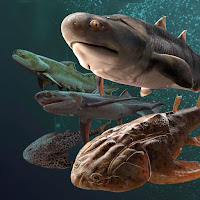 |
| Xiushanosteus mirabilis Zhu, Li, Ahlberg & Zhu, in Zhu, Li, Lu, Chen, ... Ahlberg et Zhu, 2022. |
Abstract
Molecular studies suggest that the origin of jawed vertebrates was no later than the Late Ordovician period (around 450 million years ago (Ma)). Together with disarticulated micro-remains of putative chondrichthyans from the Ordovician and early Silurian period these analyses suggest an evolutionary proliferation of jawed vertebrates before, and immediately after, the end-Ordovician mass extinction. However, until now, the earliest complete fossils of jawed fishes for which a detailed reconstruction of their morphology was possible came from late Silurian assemblages (about 425 Ma). The dearth of articulated, whole-body fossils from before the late Silurian has long rendered the earliest history of jawed vertebrates obscure. Here we report a newly discovered Konservat-Lagerstätte, which is marked by the presence of diverse, well-preserved jawed fishes with complete bodies, from the early Silurian (Telychian age, around 436 Ma) of Chongqing, South China. The dominant species, a ‘placoderm’ or jawed stem gnathostome, which we name Xiushanosteus mirabilis gen. et sp. nov., combines characters from major placoderm subgroups and foreshadows the transformation of the skull roof pattern from the placoderm to the osteichthyan condition. The chondrichthyan Shenacanthus vermiformis gen. et sp. nov. exhibits extensive thoracic armour plates that were previously unknown in this lineage, and include a large median dorsal plate as in placoderms combined with a conventional chondrichthyan bauplan. Together, these species reveal a previously unseen diversification of jawed vertebrates in the early Silurian, and provide detailed insights into the whole-body morphology of the jawed vertebrates of this period.
Systematic palaeontology
Gnathostomata Gegenbaur, 1874
Xiushanosteus mirabilis Zhu, Li, Ahlberg and Zhu gen. et sp. nov.
Etymology. Xiushan county, where the fossils were discovered, and osteus (Latin), bone; mirabilis (Latin), miracle, referring to the miraculous discovery of complete jawed vertebrates from the early Silurian.
Holotype. Institute of Vertebrate Paleontology and Paleoanthropology (IVPP) V300001, part and counterpart of a complete fish.
Referred material. A total of 20 individuals, catalogued as IVPP V300002–V300021.
Locality and horizon. Yongdong, Xiushan county, Chongqing, China; Huixingshao Formation, middle-to-late Telychian, Llandovery, Silurian, about 436 Ma (Extended Data Figs. 1 and 2 and Supplementary Information). The horizon yields fossils of diverse jawless and jawed fishes (Extended Data Fig. 3a–d), including the two taxa described here. The Lagerstätte features many head-to-tail fishes with fine details such as the complete fin web and possible vertebral column cartilage (Extended Data Fig. 3e). Furthermore, fossils of eurypterids (Fig. 1c,d) and phyllocarid crustaceans (Extended Data Fig. 3f), as well as algal fragments were also discovered alongside the fish fauna.
Chondrichthyes Huxley, 1880
Shenacanthus vermiformis Zhu, Li, Ahlberg and Zhu gen. et sp. nov.
Etymology. In honour of Congwen Shen, a distinguished writer who located his most famous story Border Town (Biancheng) at Hong’an Biancheng, close to the fossil site. Greek akantha, a thorn. Species name, Latin vermiformis, referring to the worm-like ornament on the median dorsal plates.
Holotype. IVPP V300000, the only known specimen of the genus and species, part and counterpart of a near-complete fish.
Locality and horizon. The same as for X. mirabilis.
Diagnosis. Small chondrichthyan, approximately 22 mm from the rostrum to the anal fin. Fusiform body shape; small cranium (~3.5 mm from the rostrum to the shoulder girdle) with blunt rostrum; dentition absent; branchial region posteriorly positioned in relation to the cranium; branchiostegal and hyoidean plates absent, shoulder girdle covered in large dermal plates both dorsally and ventrally, two median dorsal plates, the anterior one smaller and oblate, the posterior one larger and teardrop-shaped, with vermiform ornament; paddle-like pectoral fins lacking fin spine; Anal fin also lacking fin spine. Small, diamond-shaped scales. Small scutes or dermal plates with linear ornament along the dorsal and ventral midlines.
You-an Zhu, Qiang Li, Jing Lu, Yang Chen, Jianhua Wang, Zhikun Gai, Wenjin Zhao, Guangbiao Wei, Yilun Yu, Per E. Ahlberg and Min Zhu. 2022. The Oldest Complete Jawed Vertebrates from the early Silurian of China. Nature. 609; 954–958. DOI: 10.1038/s41586-022-05136-8
https://phys.org/news/2022-09-fish-fossil-china-oldest-teeth.html



